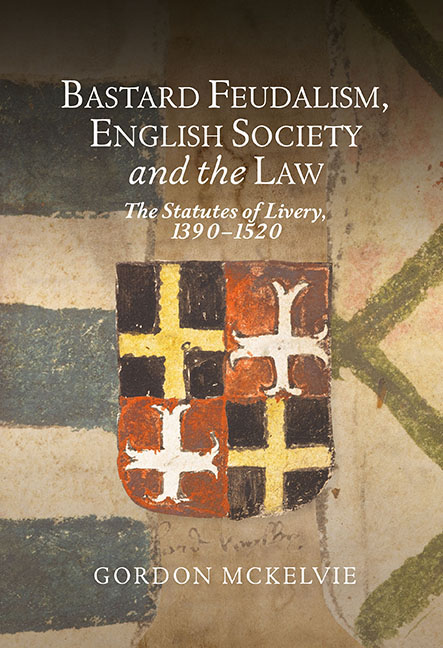Book contents
- Frontmatter
- Contents
- Acknowledgements
- Abbreviations
- Timeline of Parliamentary Activity
- Introduction
- Chapter 1 The System – Liveries and Retaining
- Chapter 2 The Early Years, 1390 to 1449
- Chapter 3 The Later Years, 1449 to 1520
- Chapter 4 Outcomes and Enforcement
- Chapter 5 The Identity of the Indicted
- Chapter 6 The Geography of the Cases
- Chapter 7 Networks and Localities
- Chapter 8 Livery and Disorder
- Chapter 9 The Urban Experience
- Conclusion
- Appendix 1 Number of Cases by Reign
- Appendix 2 Number of Cases in each County
- Appendix 3 List of Letters to Towns and Lordships
- Appendix 4 List of Local Ordinances
- Appendix 5 Letters from Henry VII to Duchy of Lancaster Officials
- Bibliography
- Index
Chapter 7 - Networks and Localities
Published online by Cambridge University Press: 02 April 2020
- Frontmatter
- Contents
- Acknowledgements
- Abbreviations
- Timeline of Parliamentary Activity
- Introduction
- Chapter 1 The System – Liveries and Retaining
- Chapter 2 The Early Years, 1390 to 1449
- Chapter 3 The Later Years, 1449 to 1520
- Chapter 4 Outcomes and Enforcement
- Chapter 5 The Identity of the Indicted
- Chapter 6 The Geography of the Cases
- Chapter 7 Networks and Localities
- Chapter 8 Livery and Disorder
- Chapter 9 The Urban Experience
- Conclusion
- Appendix 1 Number of Cases by Reign
- Appendix 2 Number of Cases in each County
- Appendix 3 List of Letters to Towns and Lordships
- Appendix 4 List of Local Ordinances
- Appendix 5 Letters from Henry VII to Duchy of Lancaster Officials
- Bibliography
- Index
Summary
While previous chapters have explained who was indicted and where such indictments occurred, this chapter explores how such connections were formed. Most of the surviving records are formulaic, which means that the precise connections that led to someone receiving an annuity, entering into an indenture of retainer or benefitting from ‘good lordship’ are obscure. The reasons why someone entered the service of a particular lord must normally be inferred from the surviving documentation. Although the precise reasons are not always clear, men did enter into the service of those of a higher rank, and therefore recruitment into the service of a great lord, or even a minor member of the gentry, must have been one of the various activities in which medieval affinities engaged. Consequently, an understanding of the ways in which people came into the service of a lord further illuminates the inner workings of medieval affinities. There broadly two interpretations about how medieval affinities operated in practice. Christine Carpenter's work has emphasised the importance of vertical ties between a particular magnate who was the head of the affinity and the members of his affinity, noting that the affinity was ‘a series of concentric circles’ around the particular noble. In contrast, Simon Walker emphasised the horizontal connections and links between members of a noble affinity which gave the affinity a greater element of coherence. Neither interpretation is fully satisfactory because these positions take two opposing perspectives: Carpenter adopts a ‘top-down’ perspective in which the lord is at the centre of everything while Walker's ‘bottom-up’ approach risks minimising the significance of the leader of the affinity. The evidence examined here approaches the topic from a different perspective: that of those who entered into an illegal retaining relationship with a particular member of the nobility or gentry. Rather than examining a particular affinity or the workings of patronage in a locality, this chapter uses the 334 cases of illegal livery and retaining to highlight broader patterns about the nature of illegal affinities. It provides additional insights into the business of retaining in late medieval England by examining the nature of connections between those indicted together for illegal retaining, employing both the ‘top-down’ perspective of landholding and the ‘bottom-up’ perspective of familial connections between those illegally retained.
- Type
- Chapter
- Information
- Bastard Feudalism, English Society and the LawThe Statutes of Livery, 1390–1520, pp. 150 - 161Publisher: Boydell & BrewerPrint publication year: 2020



